There are many memorials of war in Europe, monuments to its long and often violent history. Dachau is the site of a former Nazi concentration camp which we visited with some trepidation. It is located just 20 kilometers from the beer drinking revelry of Munich, but it is a very different and sobering experience.
The camp is now a permanent memorial to what happened there. The perimeter fence, some guard towers and administrative buildings remain, as does the gas chamber/crematorium building. All the original prisoner barracks (except the one for special prisoners) have been demolished but their foundations remain and there is a replica barrack for visitors to view. Much of the camp is now open space, but there remains a sombre, eerie feeling to the place. We were strongly affected by what we saw and what we learned at Dachau, and subsequently at Buchenwald concentration camp, and the Memorial to the Murdered Jews of Europe in Berlin.
Adolf Hitler was appointed Chancellor of German through entirely legal means on January, 30, 1933. Germany was at that time a democracy. Once the Nazis came to power they quickly moved to ruthlessly suppress all real or potential opposition. On February 27th the Reichstag (parliamentary building) was set on fire. It wasn’t proven definitively who did it, but it was blamed on an individual communist who was in the building at the time. Using fears of communism to justify his actions, within 24 hours Hitler suspended many of the German people’s basic rights (free speech, freedom of association, free press, etc.) He then quickly rounded up all of his political opponents and moved them to camps for re-education.
First they came for the communists, and I didn’t speak out because I wasn’t a communist.
Then they came for the trade unionists, and I didn’t speak out because I wasn’t a trade unionist.
Then they came for the Jews, and I didn’t speak out because I wasn’t a Jew.
Then they came for me, and there was no one left to speak out for me.
Pastor Martin Niemoller (1892 – 1984)
Why did the German people stand for this? After World War I concluded with the Treaty of Versailles, Germany was required to pay onerous (some say impossible) reparations to the victors (mainly England and France). The German economy struggled and the German government printed more money eventually leading to hyper-inflation. The life savings of most Germans were wiped out. Unemployment was very high and the people were desperate for change. Hitler was a charismatic speaker and propagandist who billed his as the ‘party of action’. He identified scapegoats to blame for the problems (e.g. communists and Jews). He said that he would restore Germany to its former greatness. It was a message with appeal to distressed Germans.
Hitler made no secret of his racist views. He believed that ‘Aryans’ (purportedly a master race of people of Northern European descent) were the superior race, that the Slavic peoples were inferior and should serve the Aryans, and that Jews, gypsies, homosexuals, and the disabled should be exterminated. Unfortunately, most people did not believe he would follow through with this, and chose instead to focus on the more appealing aspects of his message.
Dachau was the first Nazi concentration camp. It opened in March 1933 within 5 weeks of Hitler’s rise to power on the site of a closed ammunition factory. The camp was originally intended to holding German and Austrian political prisoners and Jews, but in 1935 it also began to hold ordinary criminals. In early 1937 the SS, using prisoner labor, initiated construction of a large complex of buildings on the grounds of the original camp. The construction was officially completed in mid-August 1938 after which the camp remained essentially unchanged. During the war it came to also include other nationalities including French, Poles, Yugoslavs, Czechs, Russians, and also a few captured Americans (because they had Jewish sounding names). Dachau remained in operation until it was liberated by the Americans in 1945, and was thus the longest running concentration camp of the Third Reich.
The name ‘concentration camp’ derives from the idea of concentrating the members of a group that is perceived to be undesirable in one place. The Nazis did not invent this concept. It had been used previously by the Americans, British, Cubans, and others. The term did not originally refer to the death camps of the Nazis, but it has since become synonymous with them.
Dachau was branded a re-education camp, purportedly set up to re-educate people whose views were inconsistent with the Nazi philosophy. The principle means of ‘re-education’ were torture and abuse. The camp held primarily men and boys, but there were some women in subsidiary work camps. It had 69 barrack buildings with one reserved for special prisoners (well-known or influential people and clergy who opposed the Nazi regime — at least 3,000 Catholic priests, deacons, and bishops were kept there) and one reserved for unethical medical experiments on prisoners.
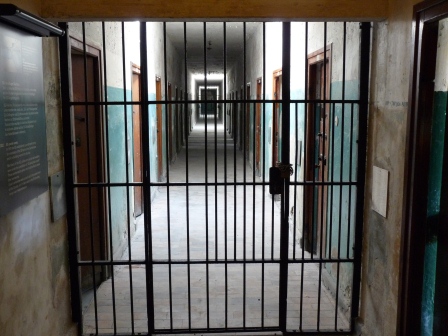
Dachau was also one of what would eventually become 24 main distribution or registration camps. Prisoners were brought into the concentration camp system, catalogued, and redistributed to one of over 1200 subsidiary camps throughout Europe. Although many people were murdered here, it was not an extermination camp like Auschwitz, none of which were on German soil. A gas chamber was installed at Dachau (we walked through it reluctantly), but it was apparently never used. This camp was intended to be used for 20 years, after which time the Nazis believed that they would have long since conquered and stabilized Europe, and that no more re-education would be required.
Prisoners did forced labour in the camp or at one of its 200 subsidiary camps, 90 of which could be reached by marching on foot. Those who could not work were murdered (or sent away to be murdered). The main door of the camp still displays the words ‘Arbeit Macht Frei’ meaning ‘work will liberate’, but there was no relationship between one’s work at the camp and their chances of being set free. A small number of people were freed from Dachau, including some to celebrate Hitler’s birthday, on the condition that they never report what happened there.
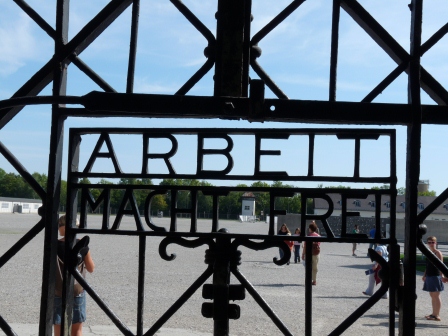
Prisoners arriving at Dachau were stripped of their belongings, identification, and very importantly for their captors, their names. Each was given a number and wore coloured badges to identify their groups (e.g. political prisoner, Jew, homosexual, criminal). They had no contract with relatives and were quickly lost in a system where they were moved to other camps without anyone knowing.
Conditions in the camp were atrocious. The camp was designed for 5000 people but held 37,000 when it was liberated. Barracks designed for 200 people held over 2000. There were not adequate or sufficient toilet facilities. Many people were sick with typhus and diarrhea. Windows were not allowed to be opened so air quality was poor. The food provided was the minimal to sustain life but of poor quality, and most of the good provisions originally intended for the prisoners were withheld by the hierarchy of guards and others who controlled the camp. Most prisoners lost half of their body weight within months of entering the camp, if they lived that long.
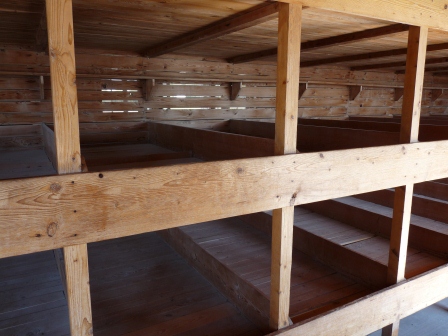
These terrible conditions, in conjunction with the torture, abuse, and forced work resulted in the death of many people. Those who couldn’t handle it any longer committed suicide, often with the encouragement of the guards. Most commonly people committed suicide by running across the ‘death strip’ and into the wire surrounding the camp where they were shot. Twice a day all prisoners (living and dead) were assembled on the parade square to be counted. At the height of the epidemics, over 200 people were dying per day.
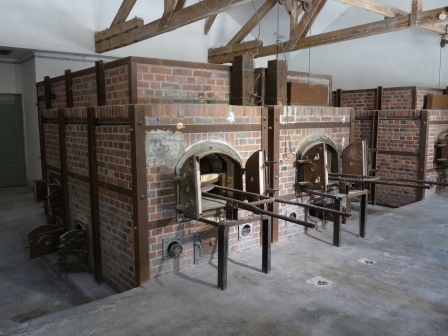
There was a hierarchy of prisoners within the camp which was deliberately organized and manipulated by the guards. Prisoners from the various groups (political prisoners, criminals, homosexuals, gypsies, etc.) were mixed together in the barracks to divide and conquer, with those who helped control the other prisoners per their captors wishes receiving special treatment (e.g. cigarettes, alcohol, access to prostitutes). For the most part, the camp was run by the prisoners themselves. There were always people willing to do the dirty jobs, including torturing and even murdering other prisoners, in return for special treatment and perhaps the hope that by currying the guards favour they might survive. At the height of the epidemics in the camp, the guards would not even enter it, and yet the camp continued to function normally, run by the prisoners themselves. I find this to be frightening example of how people, when faced with the breakdown of society, will act to save and benefit themselves even at the direct expense of others. How quickly we can revert to survival of the fittest.
Dachau became the prototype for all other concentration camps. All the Commandants of other concentration camps started here. Dachau was known as the ‘School of Violence’. where the techniques of containment, forced labour, abuse, and murder were refined.
In the final months of the war, the conditions at Dachau became even worse. As Allied forces advanced toward Germany, the Germans began to move prisoners from concentration camps nearer the front to more centrally located camps. By doing so they hoped to prevent the liberation of large numbers of prisoners. Transports from the evacuated camps arrived continuously at Dachau. After days of travel with little or no food or water, the prisoners arrived weak and exhausted, often dead or near death. The camp was constantly overcrowded and the hygiene conditions were beneath human dignity.
Due to the immaculate record keeping of the Germans, we know that 206,000 prisoners went through Dachau concentration camp. Of these approximately 40,000 people died here or in the subsidiary work camps, mainly from disease, malnutrition, and suicide.
The Dachau Concentration Camp was liberated by the 45th Infantry Division of the United States Seventh Army on April 29, 1945. The camp Commandant had fled two days before so two SS troopers officially surrendered the camp to the Americans, facilitated by a representative of the Red Cross. The American soldiers, already hardened by war, were not prepared for what they found. Outside the camp were 30 box cars full of dead bodies in advanced stages of decomposition. More bodies were found around the camp and piled high in rooms adjacent to the gas chambers and crematorium. The surviving prisoners were gaunt and sick. Seeing this, some American soldiers killed an estimated 25 to 50 of the German guards. These soldiers were later court-martialed but subsequently pardoned by General George S. Patton. After liberation, the prisoners were forced to remain in the camp for a period of time for fear of them spreading disease among the general population. Most of them had no money, homes, or families to return to. Despite improved treatment, food, and sanitation, people continued to die in the camp at the rate of 50 to 80 per day.

Despite the many atrocities, some people did survive Dachau. Although thousands survived as a result of liberation or the rare release or escape, there are no records of the names of the survivors. Only 200 of them are known. Each year, on April 20th, those who can face their painful memories are welcomed to return to Dachau. There they can share with fellow survivors, remember those who died, and they also receive free health care from the German government.
Germany is very open and honest about this dark period of its history. All school children are required to learn of this and most visit concentration camps on field trips. There were several groups of teenagers there the day we visited. I wondered what they thought. How would I feel if my country or perhaps my grandparents had been part of something like this?
Note from Patrick – This posting took me a very long time to write, and not just due to the detail required. I started and stopped many times thinking about what I was writing and why I was writing it. For some reason, having learned this information, I thought it was important to share it. Perhaps it is my small contribution to helping make sure that this never happens again.
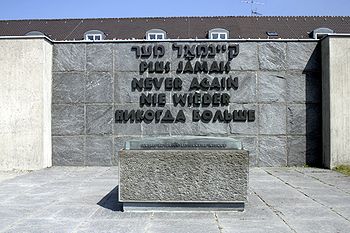
I can understand why it took you so long to writer this Patrick. Very difficult to read through. Thanks for sharing your knowledge.
Moe & Arlene
Patrick (in my view) this is a very very good piece of writing, succinct, accurate, moving-what can I say. We were at Auschwitz, and experienced similar feelings. But (and it’s a biggy) to write about it in the way you have, i.e.merging chilling facts into a readable narrative would be well beyond me, anyone else I know. You’ve put into words the tacit and emotional knowledge I have on the subject. Please send it off to some Canadian papers for consideration. Thanks we enjoyed it – Martin
Thanks Martin. I really appreciate your comment.
Very well written, Patrick. Like M&S I was in Auschwitz and I fully appreciate how hard it would be to put into words what it was like there (and why) and the oppressive feeling that still permeates the camp.
Thanks Christine. We plan to visit Poland next summer and we intend to visit Auschwitz. For now, we need a break from the holocaust memorials. Some warm sunshine would be nice too!
Hi Pat
We (Ed, Mike, Wanda and myself were just at the memorial for a visit end of September, right after our visit to Munich for Oktoberfest. Your comments on the visit are well done. Although it was very sobbering; we were glad we took the time to ‘remember’. We also went to the Juno Beach Memorial site and Museum and then to Dieppe to visit the Canadian Memorial Gravesite………I reccommend all visitors to that part of Europe to check it out, it is well worth the time.
Pat
Thanks for writing this.
Patrick, I was very moved by your words. I stopped many times reading it the first time and cried. I read it again a second time and still felt distraught. I can only imagine….actually no I don’t think I can. It was a horrific time in history that hopefully will never be repeated.
I did in fact read it again a third time. Thank you for your frankness Patrick. Your blogs enlighten and educate.
Enjoy every minute of every day!
Luv ya,
Susie Q
Hi Susan — Thank-you for your honest and throughful comment. It was hard to write too. Thanks for sticking with it (3 times, wow) It’s great to hear from you!